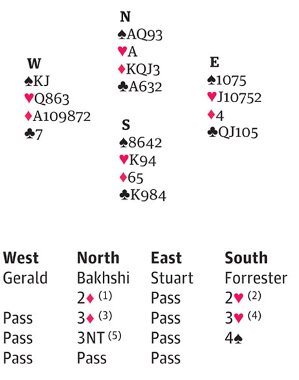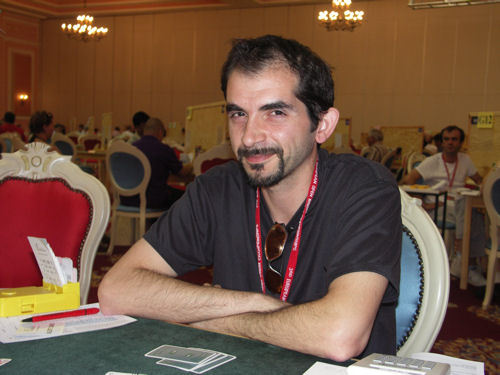Source: ![]() Thursday 4 February 2010
Thursday 4 February 2010
When an opponent plays something that might or might not be a true card, it’s best to believe it.

“Sorry, partner,” said Tony Forrester to David Bakhshi after this deal from 2010 Gold Cup final.
“I ran into a desperately unlucky trump break – the suit was 3-2 with the finesse right.”
My counterpart at the Daily Telegraph was not being entirely serious – he had in fact run into a simple yet devilish false card from his opponent, Gerald Tredinnick.
Love all, dealer North. 
 “, showing a wide variety of hands, one of which might be…
(2) a weak two bid in
“, showing a wide variety of hands, one of which might be…
(2) a weak two bid in  , in which case North would pass, but since he in fact had …
(3) a strong three-suited hand with short
, in which case North would pass, but since he in fact had …
(3) a strong three-suited hand with short  , he bid the suit below his singleton, whereupon …
(4) his partner made an artificial enquiry, and when North showed … (5) 19-20 points. South converted to game in the 4-4 major-suit fit.
West led his singleton
, he bid the suit below his singleton, whereupon …
(4) his partner made an artificial enquiry, and when North showed … (5) 19-20 points. South converted to game in the 4-4 major-suit fit.
West led his singleton  , East put in the
, East put in the  10 and South won with the
10 and South won with the  K. It seemed a dull hand – Forrester would take the
K. It seemed a dull hand – Forrester would take the  finesse, draw a second round of trumps, knock out the
finesse, draw a second round of trumps, knock out the  A and lose a trick in each suit apart from
A and lose a trick in each suit apart from  . But when he led a
. But when he led a  as the first stage, West played not the
as the first stage, West played not the  J but the
J but the  K.
K.

David Bakhshi
 K were West’s only
K were West’s only  , the contract might still be made with favourable splits in the other suits, but it would be fatal to draw a second round of trumps – that would allow East to draw two more rounds when he obtained the lead, which would be hopeless.
So Tony left the
, the contract might still be made with favourable splits in the other suits, but it would be fatal to draw a second round of trumps – that would allow East to draw two more rounds when he obtained the lead, which would be hopeless.
So Tony left the  alone and fatally played dummy’s
alone and fatally played dummy’s  K. West won with the
K. West won with the  A, gave his partner a
A, gave his partner a  ruff, received a
ruff, received a  ruff in return and played another
ruff in return and played another  to promote his twin brother’s
to promote his twin brother’s  10.
10. 
























